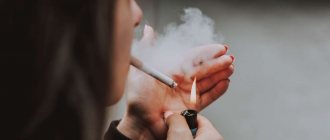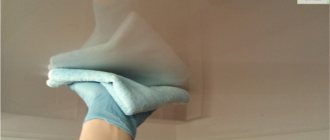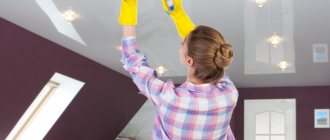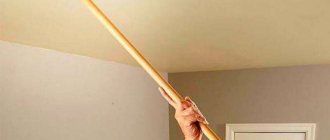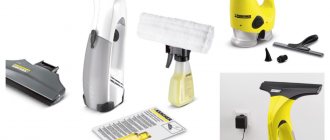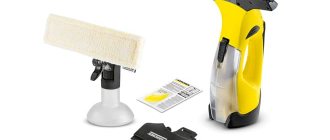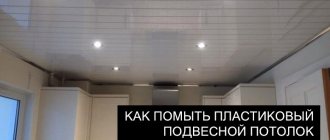At the stage of choosing the structure of a stretch ceiling, matte is often preferred, since it is undemanding in maintenance, and dust and dirt almost do not settle on the surface. But even such material requires special care from time to time. If you have a question about how to wash a matte stretch ceiling at home without streaks, then the following simple tips will help you.
Why do stretch ceilings get dirty?
Stretch ceilings get dirty like any other covering. It doesn’t matter whether it’s matte or glossy. You may have noticed that:
- soot and grease stains are most often found in the kitchen due to the release of vapors or other substances during cooking, especially on a gas stove;
- white stains may appear in the bathroom due to evaporation of water or detergents;
- in children's rooms the surface may be stained with markers or paints;
- Regardless of the type of room, yellow nicotine traces appear on the ceilings if there is smoking in the room, as well as stains due to leaks.
In addition, splashes of champagne may fall on the ceiling when opening the bottle, as well as drops of brine, compote and other products if the container explodes. Also, do not forget that dust settles on the ceiling over time.
The nature of cleaning suspended ceilings depends on the complexity of the contamination. If it is dust, you can simply wipe the surface with a dry sponge or cloth. Clean greasy and stubborn stains only with cold or slightly warm water and special products that will not harm the film.
Where to start?
Before answering the question of how to wash stretch ceilings if they are matte, you should figure out what material they are made of. Typically the material is presented:
- cloth;
- polyvinyl chloride (PVC).
In the first case, the canvas resembles a huge canvas and has excellent moisture resistance, but does not tolerate all chemicals. In the second, the choice of detergents will be much more diverse.
At the same time, you should be especially careful with the fabric and avoid repeatedly wiping the same place, as this can damage the surface or create unsightly sagging. With the exception of these points, the process of washing fabric and PVC ceilings does not differ significantly.
How can you wash suspended ceilings?
If for some reason it was not possible to wash the canvas with a dry or damp cloth, try cleaning the surface with a window cleaner containing ammonia. Choose a substance without dyes. Please note that only ceilings made of PVC film can be cleaned with this product; fabric ceilings are not recommended. The substance is easy to apply, removes various types of stains well and does not leave streaks.
If there are stains on the ceiling surface from construction or renovation, a melamine sponge will be an excellent helper. Please note that this device can only be used on matte and satin ceilings.
If you want to clean the surface and remove bacteria from the surface using a steam cleaner, then this is not a suitable option. The fact is that stretch ceilings can withstand low temperature thresholds. PVC film - no more than 50 degrees, and fabric - a maximum of 80 degrees. Considering that the device supplies steam at the boiling point level, namely 100 degrees, their use for washing can end tragically. The ceiling will become deformed, sag and may melt.
What tools are needed for washing
Before cleaning the stretch ceiling, prepare the necessary tools:
- mop with a soft attachment;
- several rags made of soft fabric;
- sponges;
- bucket or basin for water;
- stool or stepladder.
An excellent option would be a mop with a telescopic handle and a rotating platform with a removable cloth.
What cleaning products can you use?
The safest and most effective product is laundry or liquid soap. It successfully combats various types of contaminants and does not harm the surface.
An alternative to soap is dishwashing detergent. It copes well with greasy stains and plaque. You can also use washing powder, but only in foam form.
In addition, you can use window cleaners with ammonia or simply dilute ammonia in water - the effect will be the same.
Specialized stores sell products designed for cleaning suspended ceilings. Created using original technology, the substance without caustic alkalis and acids in the composition carefully cleans the surface and does not have a harmful effect on the skin of the hands. However, purchasing such a product will cost many times more than available methods. It’s better to first try to clean the surface using conventional means, and use special ones only in difficult cases.
What is not recommended to use
Stretch ceilings are a delicate product, easily deteriorate from strong mechanical influences and caustic substances, and are susceptible to high temperatures. To clean the surface, do not use:
- hard sponges and brushes;
- abrasives: powders and soda;
- substances containing acetone;
- acidic and alkaline substances, bleach or mustard;
- hot water.
During the procedure, remove all jewelry from your hands (rings, bracelets, watches) so as not to damage the integrity of the coating. Make all movements carefully, without strong pressure.
What care products should you avoid?
The matte surface requires special care. Not every remedy is suitable for this. Among them are the following:
- Powders consisting of granules. Even in dissolved form, they can damage the canvas.
- Acid, solvent and alkali are contraindicated when washing the ceiling.
- Substances containing acetone can discolor the fabric and leave stains on it.
- When cleaning with abrasive substances, hard materials and sharp tools, there is a high risk of deforming the suspended ceiling or leaving cracks or scratches on it.
- Before using stain remover, it is recommended to first test it on an inconspicuous area of the ceiling covering.
- Do not use bleach, even if the ceiling is white.
The structure of the stretch matte fabric is textured, so materials with pile are not suitable for its care.
How to wash a glossy ceiling without streaks
To wash a glossy surface and leave it streak-free, follow a certain sequence of actions and do not use aggressive or abrasive substances.
Fabric preparation
First of all, prepare the canvas for the procedure. Place a stool or stepladder so that the movements are made comfortably, otherwise you will quickly get tired. Also prepare tools and cleaning supplies and place them nearby. Remove all jewelry from your hands and put on gloves. Prepare the water in advance, making sure it is not too hot, ideally 30–40 degrees.
Test your chosen cleaning method on a small, inconspicuous area of the surface. Carry out all the necessary procedures with this area and wait 10–15 minutes. If the material has not been deformed and its color has not changed, the chosen method is suitable.
To remove dust and cobwebs, carefully vacuum the ceiling before starting work, barely touching the surface. Set the device to the lowest power. To avoid damaging the coating, wrap the vacuum cleaner brush with a thin towel. Please note that if you feel that the vacuum cleaner is dragging too much, do not touch the surface at all, keep the vacuum cleaner brush at a distance of 10–15 cm from the ceiling.
Surface washing
Clean the canvas in a certain sequence:
- Carefully examine the canvas, look for stains and spot contamination.
- Dissolve laundry soap or detergent in water and soak a rag in the solution.
- Rub the stains gently, without applying too much pressure. Repeat the manipulation until they disappear.
- If you are using a mop, keep the handle at a 45-degree angle while mopping. This way you will avoid getting splashed on yourself.
- Resourceful housewives use a spray bottle to clean complex stains. A soap solution is poured into it, which is sprayed on the surface and wiped with a rag.
- After treating the area, rinse the soap solution thoroughly with clean warm water and wipe dry to avoid streaks.
- Inspect the canvas again to make sure you have removed all the stains.
Final processing
When the main work is completed, the final processing of the ceiling is carried out. For the procedure you will need ammonia or ethyl alcohol and water.
Dilute 1 part alcohol to 10 parts water and apply to a dry cloth. Use it to treat the entire surface. Such actions will help get rid of stains and give the stretch ceiling shine.
Possible mistakes when washing a glossy ceiling
To avoid having to redo the work, remember what actions it is better not to perform:
- try not to make circular movements, as this kind of action will leave streaks;
- if the fabric consists of several parts, rub along, not across the seam;
- do not clean too often, as the structure of the film may be damaged and the shiny coating may become dull;
- Work before noon, in clear weather, to notice even minor dirt.
Cleaning contaminants in various rooms
Take care in advance about the tools and equipment that are required in each specific case. Their type, variety and quantity, as well as the complexity of the work are determined by the type of room in which the ceilings are washed.
- If this is a living room, children's room or bedroom, it is enough to wipe the surface with a dry soft sponge every six months or vacuum the ceiling once every 2-3 months.
- In the kitchen, ceilings usually get dirty the fastest. At the same time, the most persistent contaminants appear on the surface. You will have to wash the canvas as it becomes dirty at least once every 1–2 months; extreme attention will need to be paid to the area above the stove. To make cleaning easier, cover pots with lids when cooking and do not allow grease to get onto the ceiling. Carry out the treatment with special products that can quickly remove greasy marks.
- The suspended ceiling in the bathroom is constantly exposed to steam and condensation accumulation. To prevent this, ventilate the room and sometimes check the plumbing. If the canvas gets splashed or condensation collects, remove the moisture with a dry cloth. Carry out a thorough cleaning once every 2 months using a glass cleaner.
- On the loggia, surfaces quickly become covered with dust or insect excrement. Cleaning ceilings, especially in the summer, is required quite often. Wash the canvas with soapy water, rinse and dry with a dry cloth. After the procedure, wipe the surface with an alcohol solution.
How to remove stains from ceilings
The complexity of cleaning primarily depends on the nature of the contamination.
In the kitchen from soot and grease
The best way to remove greasy stains and soot on the surface is with dishwashing detergent. Dissolve the substance in water and gently apply to the problem area. Wait a little and wash off any remaining dirt with warm water.
From nicotine
If your ceiling has nasty nicotine stains, use glass cleaner or dishwashing detergent. Apply the substance to the dirt and wait a little, then rinse off the remaining soap with warm water and wipe the surface with a dry cloth.
From dust
To clean the suspended ceiling from dust, use dry cleaning. Simply wipe the canvas with a dry sponge or rag. Your movements should be light and you should not press on the surface. You can also dry clean using a vacuum cleaner.
From yellow spots
If yellow stains from leaks appear on the surface, ammonia or a glass cleaner based on it will help remove the marks.
From paint
First of all, pay attention to what kind of paint got on the ceiling. Fresh water-based emulsion is cleaned with a wet cloth, acrylic paint - only with a special means for cleaning stretch fabrics. If drops of more durable paints get on the surface, do not take risks and contact a cleaning company for help.
From primer
After repairs, traces of primer may remain on the ceiling. Such stains can be easily removed with a damp cloth soaked in a soapy solution made from laundry or liquid soap.
Useful video
In the video we will look at the process of washing a stretch ceiling using one of the well-known means:
So, how can you wash suspended ceilings to avoid streaks? As you can see, there are many options. Of course, the easiest way is to buy a specialized ceiling cleaner. But if you are an experienced housewife, you can easily prepare a solution of ammonia yourself and are not afraid to experiment, then why spend money on another bottle of cleaning product?
Cleaning ceilings is not an easy task. For any housewife, this is a serious question: how to wash the ceiling, whether it is suspended or suspended - it doesn’t matter! But believe me, it is much easier to wash suspended ceilings than to clean the surface of painted plasterboard, foam panels, or even worse, to tidy up a whitewashed ceiling!
How to care for a suspended ceiling
To keep the ceiling always sparkling clean:
- Dry clean with a sponge or vacuum cleaner from time to time.
- Remove stains immediately after they appear, before the stains are absorbed into the structure of the material.
- Regularly ventilate all rooms in the apartment to avoid excessive humidity.
- In the kitchen, when cooking, be sure to turn on the hood and cover pots and pans with lids.
Cleaning a suspended ceiling is easy. The main thing is to follow simple cleaning rules and not to use prohibited substances and tools. To minimize your cleaning time, dry-clean the surface from time to time and remove stains as soon as they appear.
Dry cleaning
With this cleaning method, clean, dry instruments made of soft material are used. Using a lint mop is not recommended. This type of cleaning is suitable for removing minor stains. For example, dust, cobwebs, stubborn stains or moisture. You can simply brush away the cobwebs without touching the ceiling covering.
For dry cleaning, a vacuum cleaner with a foam attachment works well. But you need to keep a distance of at least 3 cm. Touching the coating with the nozzle is not allowed.
Cleaning without the use of solutions and foam is not suitable for removing heavy or stubborn dirt. Such cleaning does not take much time and effort; it is performed for preventive purposes.
